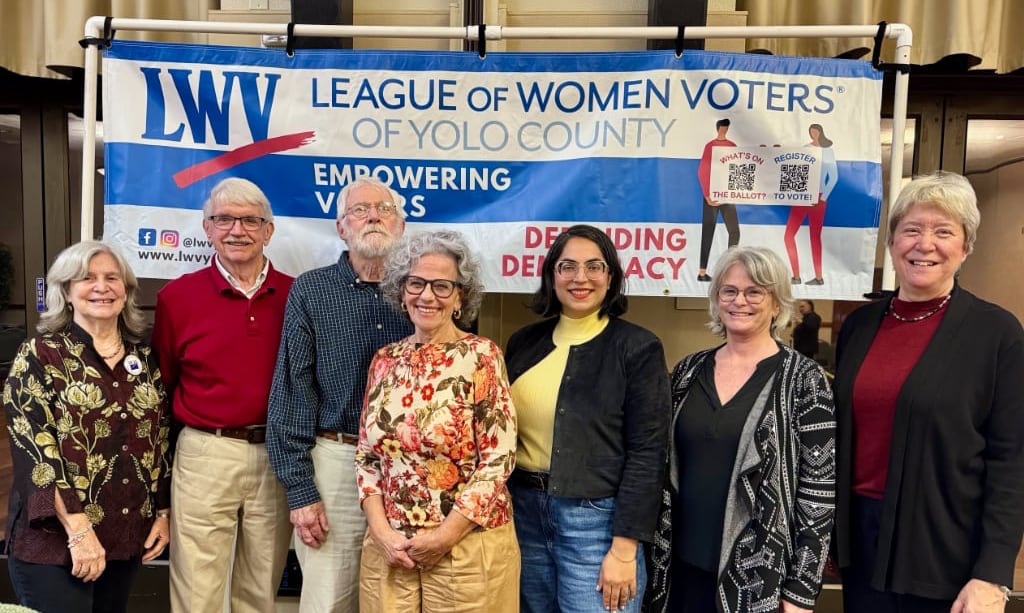This LWVYC Voter Education Event, Understanding the Proposition 50 Special Election: Nonpartisan Voter Information for Yolo County, provided a 1-hour non-partisan presentation to approximately 50 community members. The event was live-streamed and also viewed virtually by many from home. The event offered an informative overview of the single November 4th Special Election Ballot Proposition 50.
LWVYC members summarized the initiative history, its proposed impacts on congressional redistricting for the 2026, 2028 and 2030 federal elections, and the arguments made by both supporters and opponents. Voter information, including registration requirements, important mail-in, drop-box, and in-person ballot return options, dates and vote center locations, were also reviewed. Woodland TV will continue to make the League presentation available on its YouTube website through election day, November 4th.
We want to thank Dale Dennis and his crew from Woodland TV, who live-streamed and recorded this presentation for future viewing. The recording will be available online until after the election on November 4.
We also thank the City of Woodland and the staff at this beautiful Community and Senior Center for the use of this facility, and the many League of Women Voters volunteers who made this event possible.
Photos
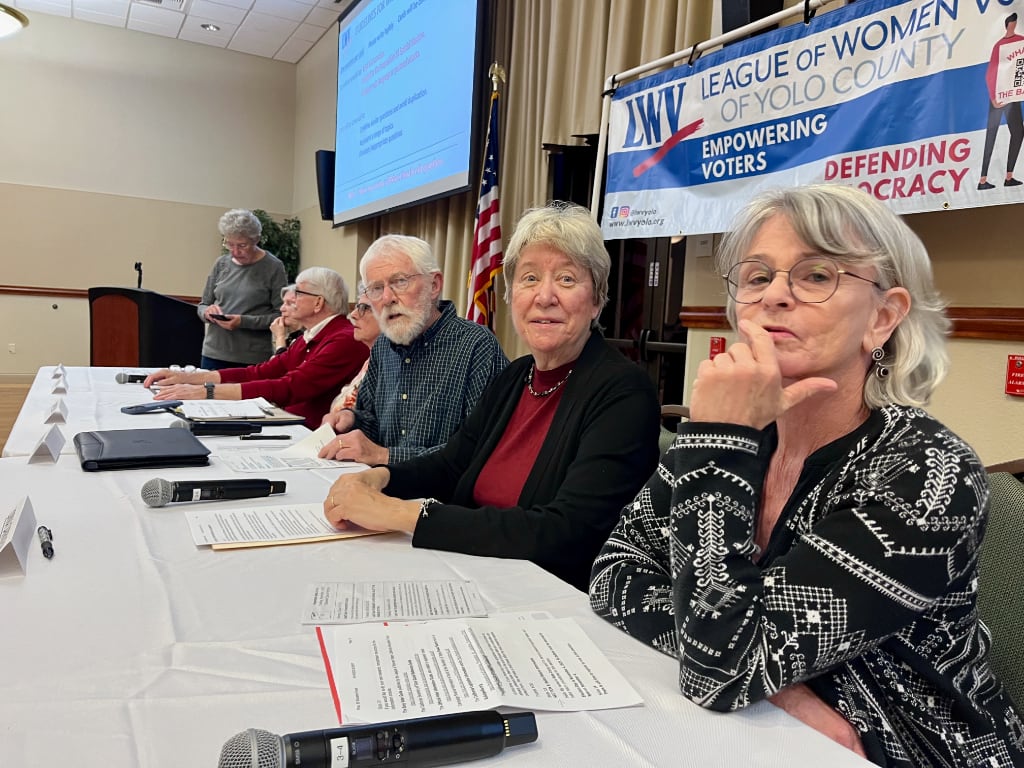
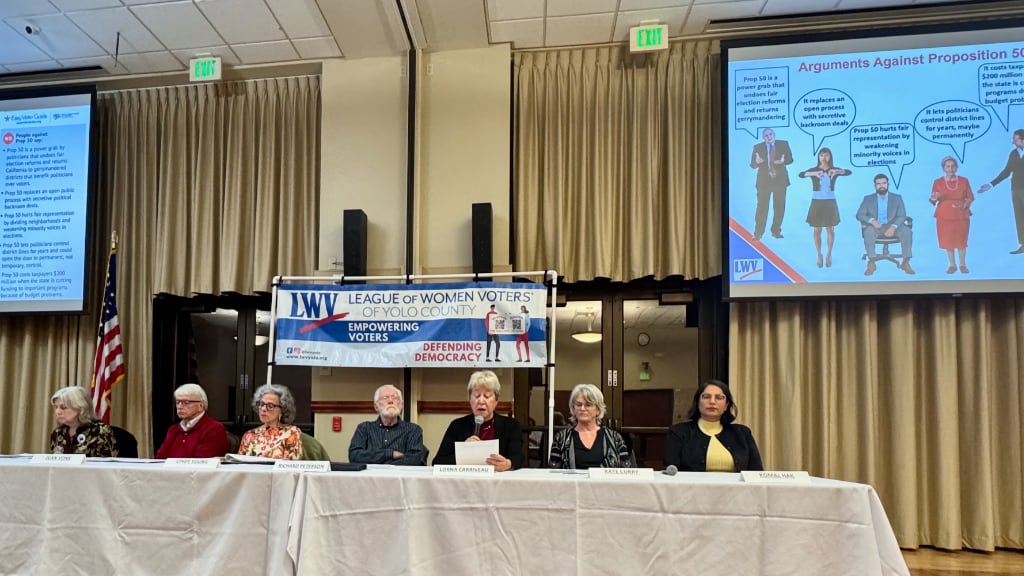

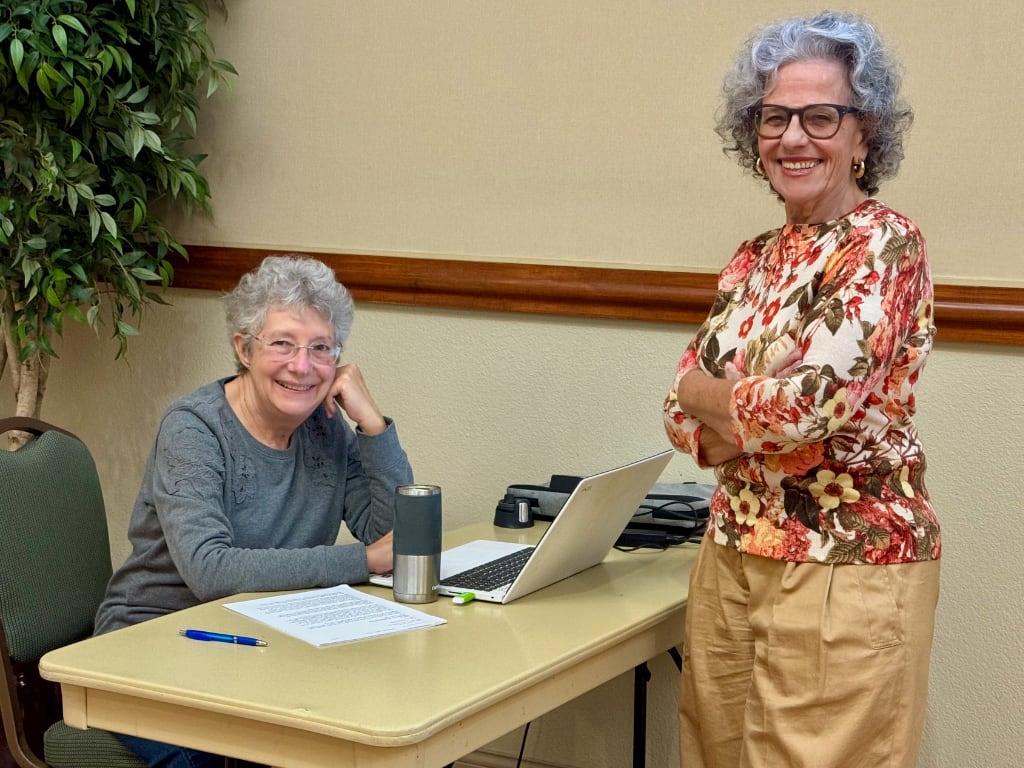
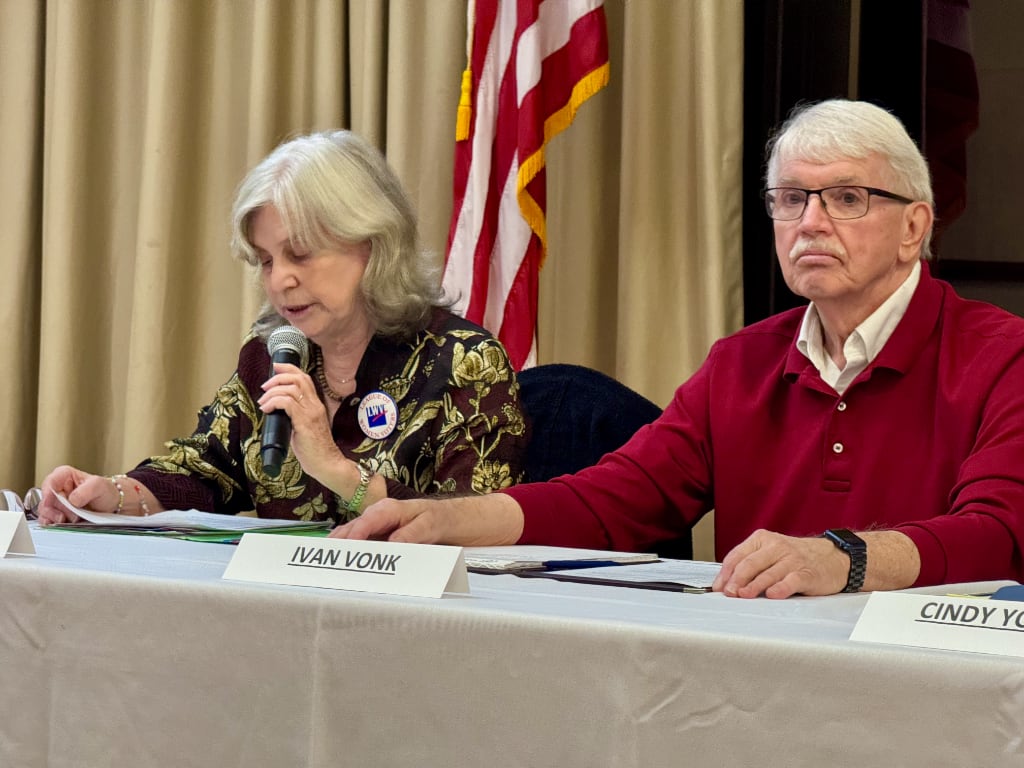
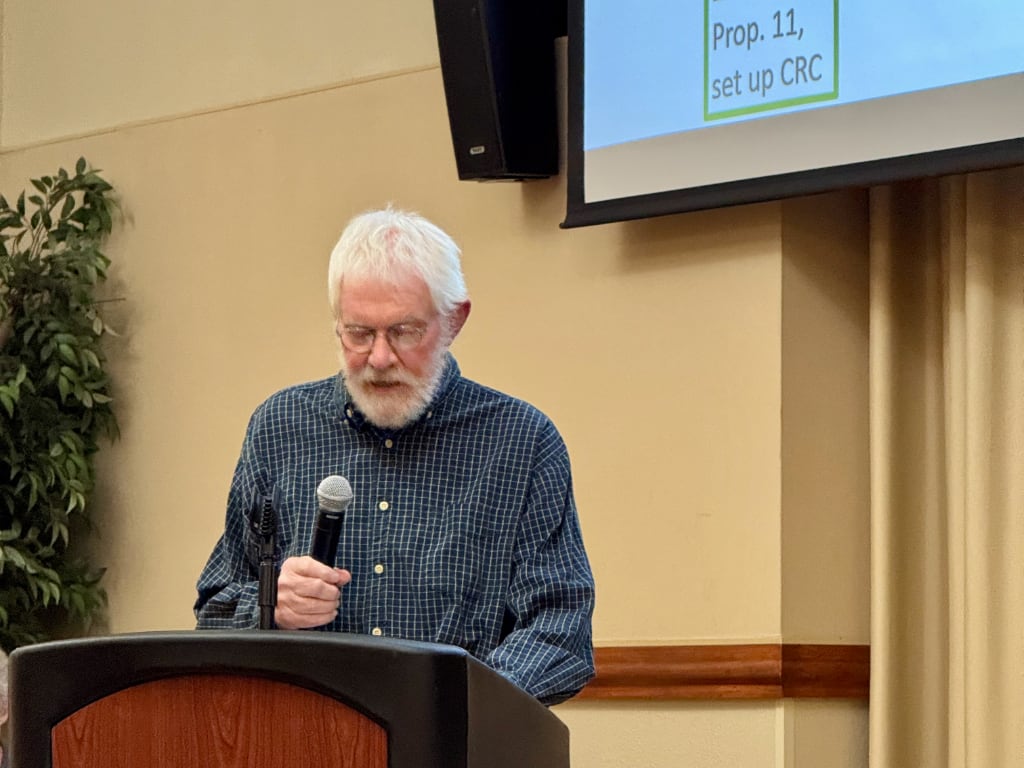

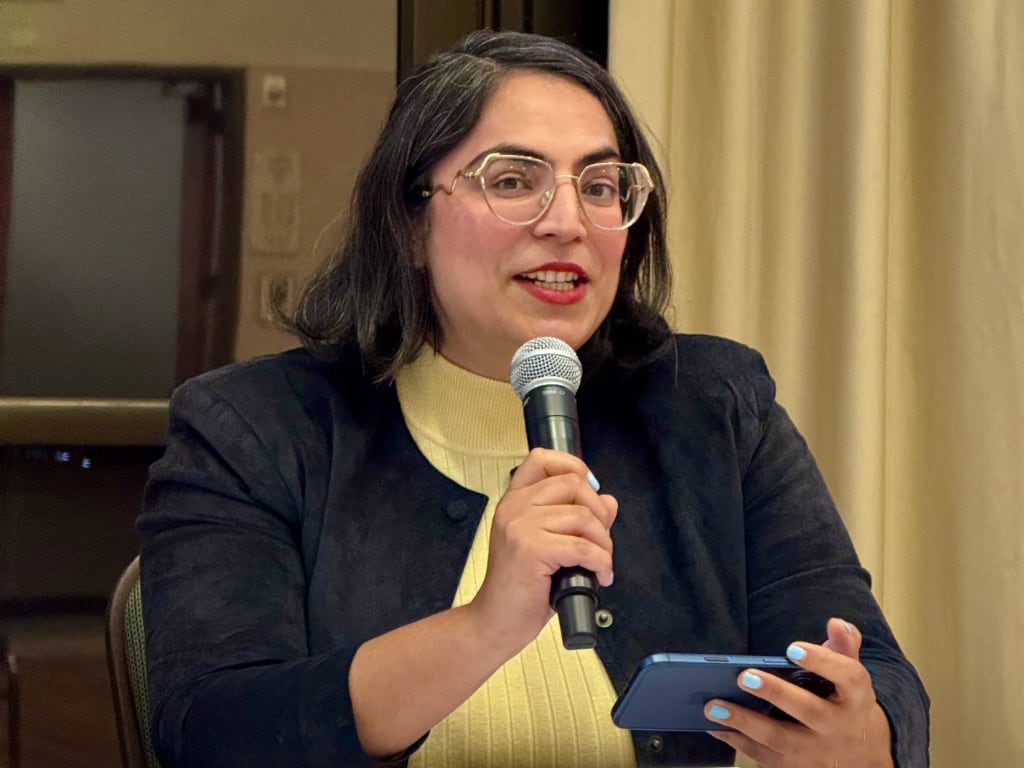
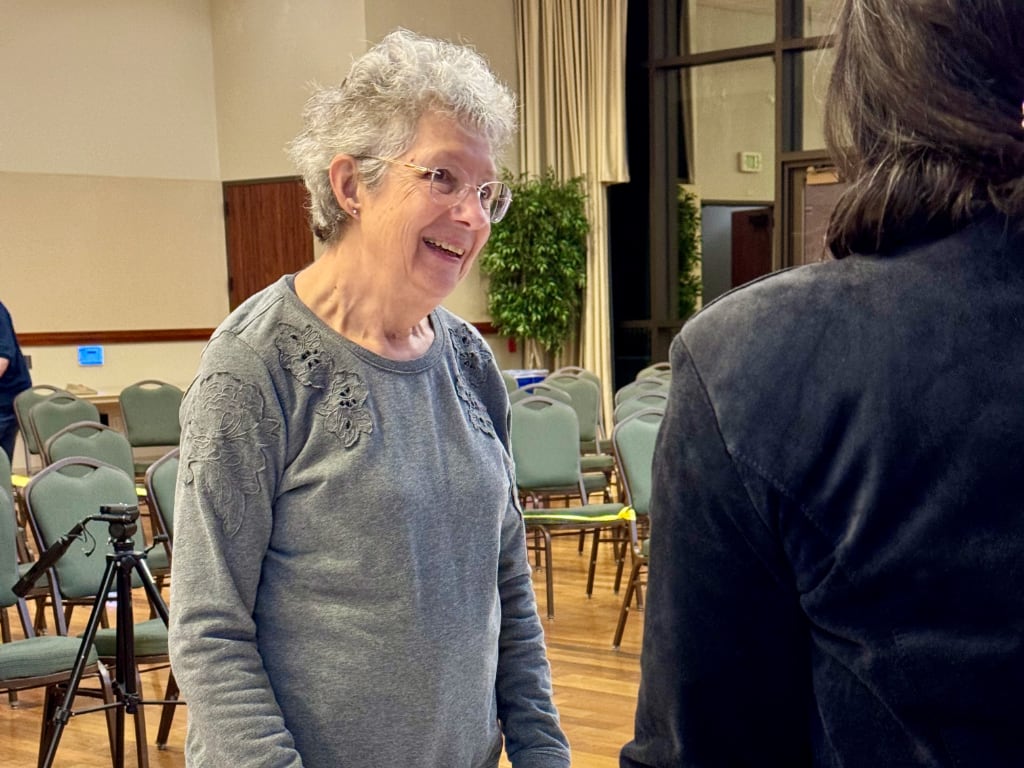
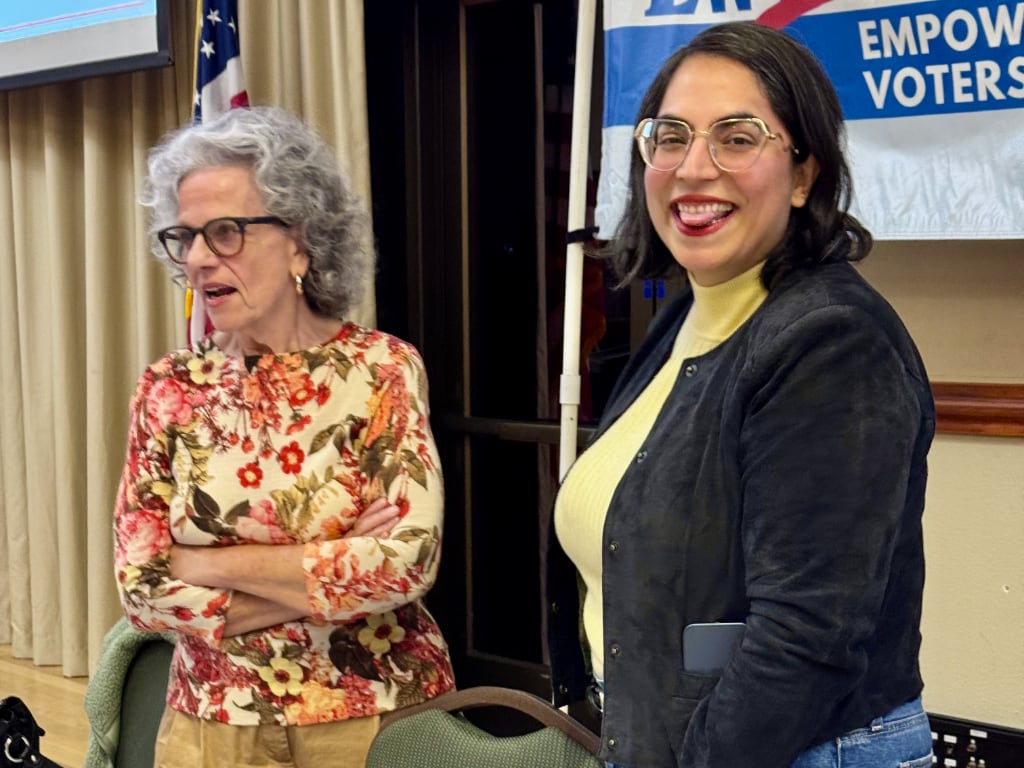
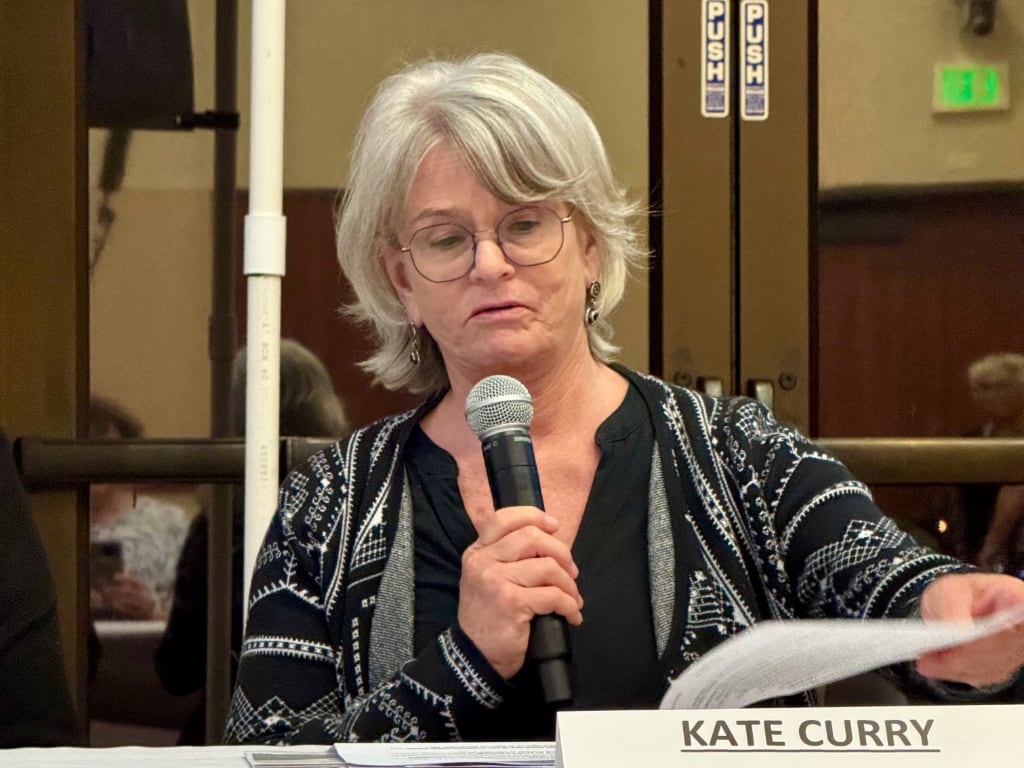
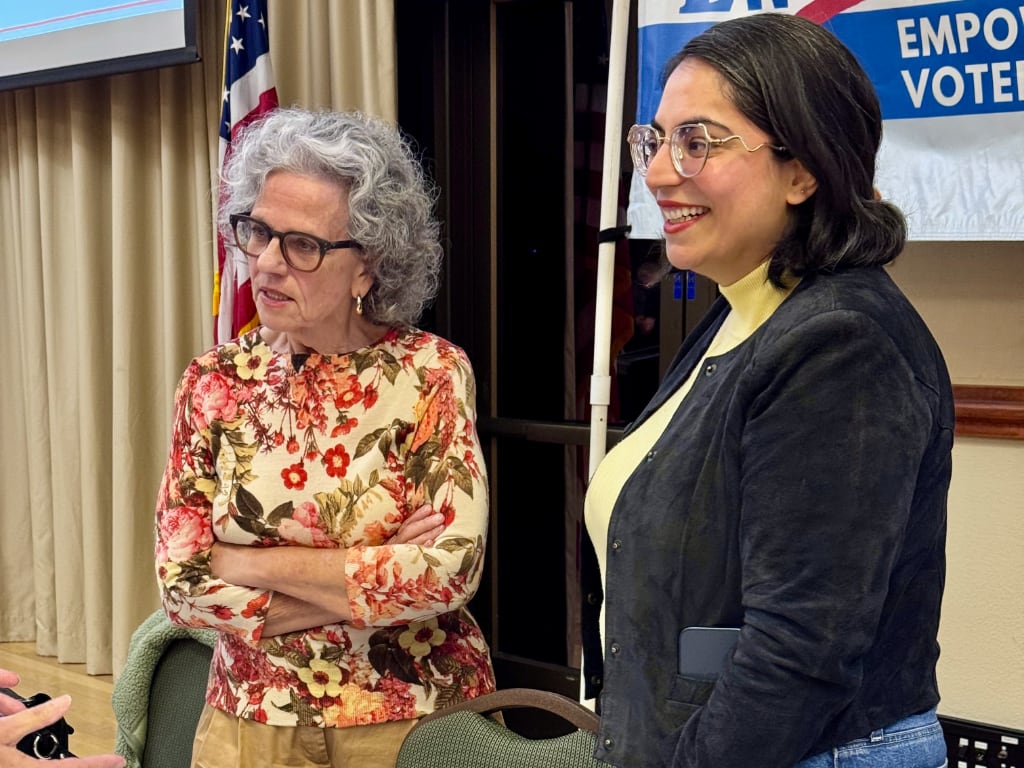
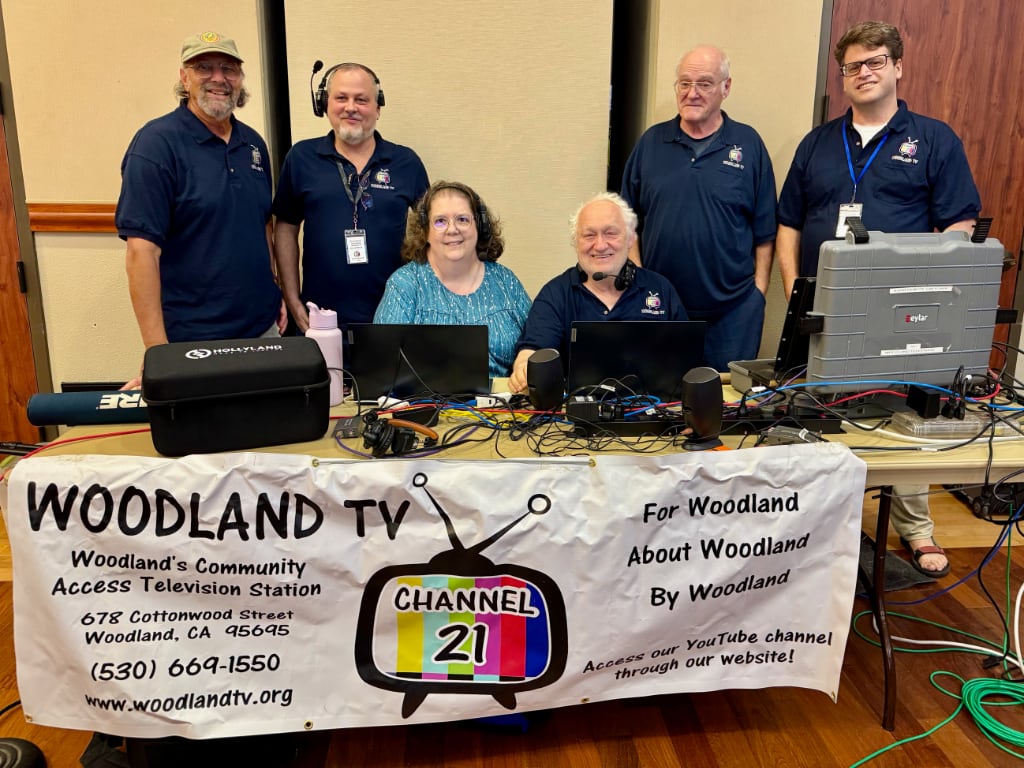

In the News
Daily Democrat: Yolo League hosts ‘scripted’ forum on Prop. 50
Davis Enterprise: League of Women Voters looks at Prop 50
Original Event Post
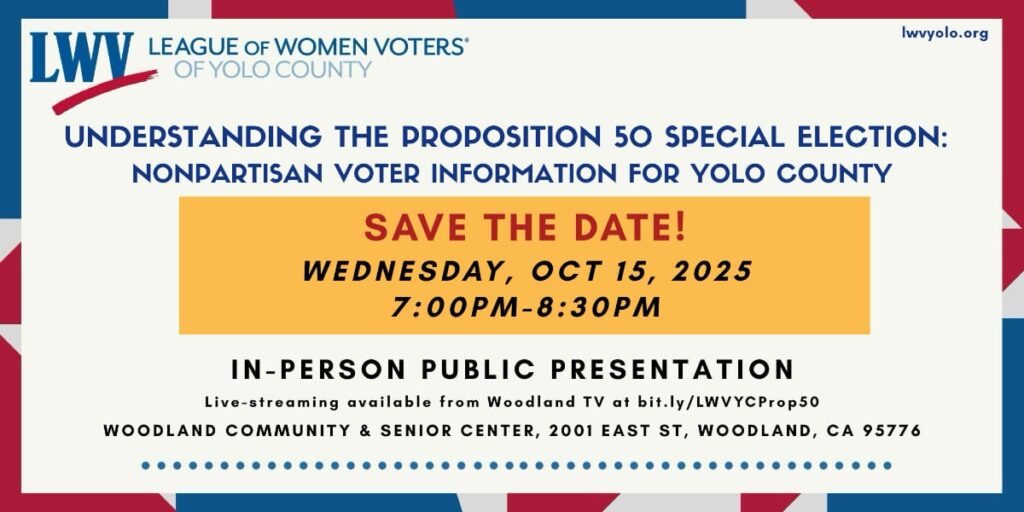
Looking ahead to the Special Election, and the best way for our League to make a positive contribution to the community conversation, LWVYC will host an important public voter education event on October 15th.
Day: October 15, 2025
Times: Presentation begins at 7:00 pm. Doors open at 6:45 pm.
Location: Woodland Community & Senior Center, 2001 East St., Woodland, CA 95776 (map)
Live Stream: Woodland TV will livestream the presentation. Watch on YouTube.
Cost: Free
Despite the California League’s decision to not take a position on Proposition 50, local Leagues are encouraged to continue our tradition of active, visible local voter education.
On October 15th, LWVYC will present “Understanding the Proposition 50 Special Election: Nonpartisan Voter Information for Yolo County”. Our members will distribute the California League’s non-partisan November 2025 Easy Voter Guide, which will serve to guide our presentation.
Our members will help voters understand ballot access and ballot return features of this election, along with a concise summary of the single November ballot measure, Proposition 50. Current congressional district maps and proposed federal representation changes for Yolo County residents and the State will be presented.
Members and the Public are Invited
It is important to remember that all League-sponsored voter education events honor our nonpartisan League policies while presenting voter registration, ballot issue and election participation information.
Please note: No campaign literature or paraphernalia, such as signs, T-shirts, hats, buttons, etc., will be allowed inside the meeting room.
This is a free event. RSVP using the form below.
Event is over.
Transcript of Presentation
SECTION 1: INTRODUCTION
Thank you for joining us this evening to learn more about Proposition 50. My name is Michelle Famula, and I am privileged to serve as this year’s President of the League of Women Voters of Yolo County.
Our Countywide League is part of the national League of Women Voters, which began over 100 years ago as a non-partisan organization to encourage informed election participation by all eligible voters. As a non-partisan civic group, we do not endorse candidates or political parties. However, as a part of our mission to support voting and encourage election participation, we sponsor events like this evening’s presentation. These events are structured according to guidelines established by the League of Women Voters of California to promote fairness and civil discourse.
Slide 6
This evening’s presentation focuses on the upcoming November 4th California Special Election. The ballot for Yolo County voters has a single state-wide ballot measure, Proposition 50. No candidates or other local measures will appear on the Yolo County ballot.
Slide 7
Tonight’s program reviews what a proposition is and how it is placed on the ballot. To better understand Proposition 50, we will also review the history of the California Citizens Redistricting Commission and explain why a special election is required for this measure on November 4. We will present the legislative provisions of Proposition 50, what a yes or no vote means, and the views of the supporters and opponents of Proposition 50 We will also emphasize why voting is so important in this Special Election.
The advocacy positions presented during this evening – both for and against the measure– have been scripted from nonpartisan voting documents approved by the Secretary of State. These positions are NOT necessarily those of tonight’s speakers.
Tonight is an educational presentation. We will not be offering any advocacy on the part of the League at this event. We will also share nonpartisan resources so you can research this proposition further as you wish.
Slide 8 (repeat of slide 2)
At the conclusion of our presentation, we will answer some written questions from our live audience. We ask you to remember, however, that we are not the experts on the topics being presented, but we will do our best to respond to questions or refer you to appropriate resources.
Those of you in attendance received a card as you entered for writing questions. The guidelines for written questions are on the screen. Our questions-sorting team of League members will combine duplicates and eliminate inappropriate questions, rude language or personal attacks. When you have completed your question card, please pass it to the end of the aisle. Volunteers will collect questions until approximately 7:30 p.m.
Slide 9 (repeat of slide 3)
Now for some housekeeping items. Please silence your phones and other devices, and do not take any photos. This event is being recorded and live-streamed by Woodland TV and will be available soon on their website with a link from our League site for future viewing.
Please refrain from demonstrations in opposition to or support of the information provided during this presentation. We appreciate your courtesy to those here in attendance and viewing remotely. Attendees who cause disruptions interfere with our educational goals and will be asked to leave.
THANK YOU.
SECTION 2: BACKGROUND ON PROPOSITIONS
Slide 10
Hello, my name is Ivan Vonk, and I’m going to provide background information on how propositions are managed in California and how they are placed on the ballot for a vote in order to change existing laws or enact new ones.
Propositions are proposed laws that are placed on the ballot in one of two ways.
• Any California voter can put an initiative or a referendum on the ballot by writing a proposed measure and collecting the required number of qualified voter signatures.
• The Legislature can place constitutional amendments, bond measures, and proposed changes in law on the ballot.
Propositions require a 50% + 1 “YES” vote to become law.
Propositions can change current law, create new laws, or amend the State Constitution.
Slide 11
Special Elections are held outside of regularly scheduled elections. A special election may be held to fill sudden vacancies in public office, consider ballot measures outside of a general election, or to decide on a recall. The reasons can range from local issues to statewide contests.
Slide 12 (repeat of slide 6)
The upcoming November 4th California Special Election contains the single ballot measure, Proposition 50, which is an amendment to our current California Constitution that will remain in effect through 2030. The slide on the screen shows the proposition as it appears on your ballot.
Slide 13
There are many ways to evaluate a ballot proposition. Some questions to consider include:
• What does the measure seek to accomplish?
• Who are the sponsors and opponents of the measure? The California Secretary of State’s office publishes Power Search online, where you can check where the money is coming from.
(Link to be put on resources slide.)
• Will the measure create conflicts in law that may result in lawsuits or cause more problems than it will resolve?
• Does the measure create its own revenue source or address how it will be funded?
• Are supporters or opponents providing information of substance about the measure or using distortion tactics that create half-truths?
Slide 14
The California State League of Women Voters has not taken a position on this Special Election ballot measure. As a non-partisan organization, the state League, like our local League, has a core principle to neither endorse nor oppose candidates or political parties. Remaining non-partisan, the California League neither supports nor opposes the legislative proposals in Proposition 50.
Instead, the state League encourages voters to:
• understand how the State’s current law works to determine congressional districts,
• learn how the proposed ballot measure amends that process and impacts voting maps through mid-cycle redistricting,
• hear the arguments ‘for’ and ‘against’ the measure, and
• determine what is best for our county residents and our state.
Be sure to Vote!
THANK YOU
SECTION 3: CALIFORNIA REDISTRICTING COMMISSION HISTORY AND PROPOSITION 50
Slide 15
Hello, my name is Cindy Young. I am going to explain how California created the current Congressional voting districts that were used in the 2024 congressional election, and how a vote on Proposition 50 is required for new legislative redistricting maps to be adopted for 2026, 2028 and 2030.
The U.S. Constitution requires that new congressional district maps be drawn using the population data from the most recent census taken at the start of each decade. In California, prior to 2010, our congressional district map was drawn up by majority vote of the legislature and signed by the Governor.
Slide 16
In 2008, the voters of California approved a state constitutional amendment, Proposition 11, known as the Voters First Act, requiring a non-partisan redistricting commission to be created to draw up statewide voting districts, independent of the state legislature.
The California Citizens Redistricting Commission was established to draw state legislative districts. The Commission was designed to be non-partisan to prevent “gerrymandering”, the practice of manipulating district boundaries to give an unfair advantage to one political party or group favored by the state legislative majority in office. Political gerrymandering is not prohibited by federal law, but the California Constitution now explicitly prohibits maps that “favor or discriminate against an incumbent, political candidate, or political party.”
Slide 17
In 2010, voters approved Proposition 20 and expanded the commission’s authority to also draw state congressional districts for the U.S. House of Representatives.
Slide 18
The propositions passed by the voters created a California Citizens Redistricting Commission that consists of 14 California citizens selected through a rigorous process designed to ensure political balance and independence. The members are divided into three groups: Five registered Democrats, five registered Republicans, and four registered with neither of those parties. The selection process is handled by the California State Auditor and involves several steps.
The Commission must follow certain rules and may not draw districts that favor a candidate or political party.
The Commission must also seek and use public input from communities about which neighborhoods should be kept together. The congressional district maps they create still require the signature of the Governor.
Slide 19
Why does Proposition 50 require a Special Election, and what does it do?
California’s Proposition 50 requires a special election and voter approval because it seeks to amend the state constitution. The measure would temporarily suspend the use of the Citizens Redistricting Commission, which currently draws congressional district maps, and instead allow the legislature to create a new map. Since this change would alter the constitution and override a voter-approved process, it must be approved directly by the voters.
The bill that led to the ballot measure was introduced as Assembly Constitutional Amendment 8 by House Speaker Robert Rivas and passed both legislative houses with the two-thirds vote required for a state constitutional amendment. The amendment was signed by Governor Newsom, who set the date and procedures for the November 4th Special Election in August. The Secretary of State assigned the measure to the ballot for voter approval as Proposition 50.
The California legislature placed Proposition 50 on the ballot in response to newly redistricted congressional maps drawn in Texas and similar redistricting proposals called for by legislatures in other states.
THANK YOU
Slide 20
SECTION 4: PROPOSITION 50 IMPACT
Hello, I am Richard Peterson, and I will be presenting information about Proposition 50’s anticipated impact.
For clarification, Proposition 50 only affects U.S. Congressional House districts, which are for federal offices.
(Point to slide)
If a majority of California voters approve Proposition 50, the Congressional District Map that was redrawn by the legislature this year will be used for the 2026, 2028 and 2030 congressional elections. After the next census in 2030, the Citizens Redistricting Commission will then resume its role and use the 2030 census to redistrict the California congressional map.
Slide 21
Unlike the districts drawn by the Citizens Redistricting Commission, the proposed districts do take into account the party registration of voters.
Proposition 50 would also change the percentage of registered Republican voters and Democratic voters in many districts so that:
• Democratic voter representation would have an advantage in five districts currently represented by Republicans, and
• More Democratic voters would be pulled into five swing districts currently represented by Democrats.
Regardless of where you stand on this proposition, if it is passed, it does not necessarily secure more Democratic congressional seats. Who wins or loses each seat is dependent on what the voters in that district choose.
As to the new district maps themselves, under AB 604 – the legislative map the ballot would adopt if Proposition 50 passes – Yolo County will remain split across congressional districts. Some cities and neighborhoods that today share a congressmember would be shifted into different districts, changing who represents them in Congress for the 2026, 2028, and 2030 elections. The result could alter political incentives, outreach and federal attention for those communities.
Slide 22
As you can see from the map on the screen, Yolo County currently falls within two Congressional Districts. (Use laser pointer) The bulk of Yolo County, including Davis, Woodland, Winters and most of the unincorporated areas are all within Congressional District 4, currently represented by Mike Thompson. The City of West Sacramento is currently located within the boundaries of Congressional District 7, represented by Doris Matsui.
Slide 23
The maps created by Proposition 50 would result in parts of Yolo County being located in three – instead of two – congressional districts. Most of the geography in Yolo County would remain in Congressional District 4. West Sacramento and some surrounding areas would shift to Congressional District 6, represented by Ami Bera. A portion of the southern area of Yolo County, including Davis south of Interstate 80, would shift to Congressional District 8, which is represented by John Garamendi.
Slide 24
Statewide, changing the existing maps would increase counties’ costs to update their election materials. It would cost the state itself about $200,000. For the state, that’s less than one-tenth of one percent of its $220 billion budget.
[Slide 24 may change to provide more information about Yolo County’s costs if we hear back from Jesse Salinas’ office in time.]
THANK YOU
SECTION 5: PROPOSITION 50 ARGUMENTS
Slide 25
Hello, my name is Lorna Carriveau. I am here tonight to speak to you about what the people who oppose and the people who support Proposition 50 are saying and the financial contributions received to date for their positions. As to financial support, because donations are still occurring, it may not be possible to identify all financial contributors on either side in time to publicize this to voters before the election.
The slide on the screen shows a summary of arguments in favor of Proposition 50. This summary is in the Easy Voter Guide, published by the League of Women Voters California Education Fund. It provides information about Proposition 50 in straightforward language, as well as information on voting and voter registration.
According to the Easy Voter Guide, Proposition 50 supporters are saying:
• It is a short-term, temporary emergency plan needed to stop an attempt to unfairly rig next year’s congressional election.
• It gives voters the ability to approve the district lines in this election.
• It creates fair maps that reflect California’s diverse communities and protect our voices from partisan gerrymandering.
• It keeps California a leader in fair elections by preserving its independent redistricting system.
• It strengthens democracy by making sure that Republicans don’t have an unfair advantage in Congress.
Slide 26
The Official Voter Guide published by the Secretary of State describes the arguments in support of Proposition 50 as follows:
Proposition 50 – The Election Rigging Response Act – approves temporary, emergency congressional district maps to counter Donald Trump’s scheme to rig next year’s congressional election and reaffirms California’s commitment to independent, nonpartisan redistricting after the next census. Vote Yes on 50 for democracy in all 50 states. Learn more at StopElectionRigging.com.
Slide 27
As of October 13, 2025, there have been over 147,000 contributions in support of Proposition 50, with over $143.8 million being raised according to the California Secretary of State. The top 10 contributors are listed here:
• Yes on 50 Committee: $11.4 million
• House Majority PAC: $36.6 million
• Fund for Policy Reform: $10 million
• MoveOn.org PAC: $6.9 million
• California Teachers Association: $3 million
• National Education Association: $3 million
• Michael Moritz: $2.5 million
• California Nurses Association: $2.5 million
• Reed Hastings: $2 million
• Consumer Attorneys of California Issues PAC: $2 million
The first two on the list consist of smaller donations contributed to political committees in support of Proposition 50.
Slide 28
This slide shows a summary of arguments against Proposition 50, also found in the Easy Voter Guide from the California League of Women Voters.
According to the Easy Voter Guide, opponents of Proposition 50 are saying:
• Prop 50 is a power grab by politicians that undoes fair election reforms and returns California to gerrymandered districts that benefit politicians over voters.
• It replaces an open public process with secretive political backroom deals.
• Prop 50 hurts fair representation by dividing neighborhoods and weakening minority voices in elections.
• It lets politicians control district lines for years and could open the door to permanent, not temporary, control.
• It costs taxpayers $200 million when the state is cutting funding to important programs because of budget problems
Slide 29
The Official Voter Guide, published by the Secretary of State, describes the arguments against Proposition as follows:
Prop. 50 was written by politicians, for politicians – dismantling safeguards that keep elections fair, removes requirements to keep local communities together, and eliminates voter protections that ban maps designed to favor political parties. Vote NO to protect fair elections and keep citizens – not politicians – in charge of redistricting.
Slide 30
Also as of October 13, 2025, there have been 268 contributions in opposition to Proposition 50. Over $83.8 million has been raised according to the California Secretary of State. The top 10 contributors are listed here:
• Congressional Leadership Fund: $41.6 million
• Charles T. Munger Jr.: $32.7 million
• Thomas M. Siebel: $1 million
• Kevin McCarthy for Congress: $1 million
• Jim Jordan for Congress: $300,000
• Douglas M. Leone: $250,000
• Ken Calvert for Congress: $250,000
• Redding Rancheria: $150,000
• Vince Fong for Congress: $100,000
• Jay Obernotle for Congress: $100,000
Contributions to support or oppose Proposition 50 are from individuals or organizations from both within and outside of California. More detailed information on donations can be found at Power Search on the Secretary of State’s website.
Slide 31
If you would like to do your own research, nonpartisan resources for the information include:
Slide 32 [pause to collect questions]
At this time, if you have any written questions and have not done so already, please pass them to the end of your aisle so a volunteer can collect them. We will take a brief break after the next presenter speaks.
THANK YOU
SECTION 6: Ballot Return Information
Slide 33
Hello. My name is Kate Curry and I’m here to present important dates and ballot return procedures for this election.
Election Day is November 4, 2025. All ballots must be returned by 8 pm on November 4.
Slide 34
There is still time to register to vote in this election.
The last day to register online is October 20th to vote in the November Election.
• Check your address is up to date at https://registertovote.ca.gov
• All voters should go to the Secretary of State Website to update their registration information by October 28 to receive a mail-in ballot before the election.
(The link is in the Easy Voter Guide).
• MAIL BALLOTS ARE NEVER FORWARDED TO A NEW ADDRESS. The address must be updated with the Secretary of State’s office to receive a ballot in the mail at your current address.
If you are registered to vote and have not yet received your ballot, please contact the Elections Office as soon as possible at 625 Court St. in Woodland. Their telephone number is 530-666-8133.
Slide 35
Voters may ALSO register same-day at any in-person Voting Center and receive a provisional ballot right up to 8 pm on November 4th.
Slide 36
• Vote-by-Mail Ballots began going out in Yolo County on October 6th.
• Registered Voters who did not receive a mail ballot should contact the Yolo County Elections office either in person at the County Administration Office in Woodland or by phone at 530-666-8133.
• A completed ballot may be dropped in any U.S. mailbox with a collection time before 8pm on November 4th. Check the collection time on the mailbox to be sure your ballot will be picked up on time!
• No Stamp is needed.
• Voters MUST sign the outside of the ballot envelope for their vote to be counted.
Slide 37
A completed ballot may also be dropped off at any Ballot Drop Box or in-person Voting Center before 8pm on November 4th.
Ballot Drop Boxes in Yolo County are available October 6 – November 4
There are 8 OUTDOOR drop boxes in Yolo County located at:
• Clarksburg Library
• Davis: UCD Campus and Davis City Hall
• Esparto Library
• Knights Landing Library
• West Sacramento City Hall
• Woodland: Woodland Community College Campus and Woodland Post Office
There are also SEVEN businesses in Davis, West Sacramento, Winters and Woodland with drop boxes available INDOORS during store hours October 6-November 4.
ALL Drop Box locations are listed in the Yolo County Election Office Voting Guide mailed to voters.
All Ballots must be dropped off in those boxes by 8pm on November 4, 2025.
Slide 38
Voting Centers in Yolo County:
The November 4th Special Election will only have SIX In-Person Early Voting Centers:
• Davis, Woodland and West Sacramento in-person centers will open October 25.
• A second center on the UC Davis Campus and a center in Winters will open on November 1st.
• The UC Davis Campus will open an additional center on ELECTION DAY ONLY, November 4th in the ARC Ball Room.
• All Vote Centers are open 10:00 a.m. – 6:00 p.m. through November 3. On Election Day, November 4, the hours are extended.
ALL Vote Center locations are listed in the Yolo County Election Office Voting Guide mailed to voters.
Slide 39
ALL VOTING CENTERS WILL BE OPEN ON NOVEMBER 4TH from 7:00AM to 8:00 PM.
Polls close at 8:00pm. If you are in line to vote at 8:00pm, you will still be allowed to vote.
Slide 40
We will now take a 10-minute break to allow our volunteers to review and sort the questions audience members submitted earlier.
THANK YOU
SECTION 7: Audience Questions and the Importance of Voting in the Special Election
Slide 41
Hello. My name is Komal Hak and I’m here to present a few of the questions we have collected this evening from our audience and to conclude our program with a reminder about the importance of voter turnout in this and other Special Elections.
Reads question(s) if collected.
Slide 42
From the Revolutionary War to the Voting Rights Act, Americans have fought to protect and expand their right to vote. Voting shapes our government and our society.
Voting gives us a voice in government decisions and to choose representatives who align with our values and priorities. Voting holds elected officials accountable for their actions and policies. It encourages politicians to consider the needs and opinions of their constituents. Voting shapes the future for upcoming generations to help ensure a better society for future citizens.
Abstaining from voting also has an impact, but it may not be the one you want. Failing to vote is not the same as voting “NO”.
Voting is the mechanism by which we make adjustments and improvements to our laws or prevent policy changes we believe are harmful to our community. Abstaining prevents you from having your voice heard and your opinion counted. Your vote matters.
During the 2024 presidential election, approximately 80% of registered voters in Yolo County voted. That is a very high turnout. Unfortunately, Special Elections, those that occur outside of the regular election schedule to address specific, time-sensitive issues, typically have much lower rates of participation.
This is concerning because Special Elections often include critically important decisions that will dramatically change governing policy or determine how state dollars are spent or alter civil liberties promised in our state constitution.
Slide 43
One of our League’s missions is to encourage informed and active participation in voting. This is especially important to prevent a simple majority of only a small fraction of eligible voters from making a profound change in our laws and regulations. We encourage all of you to vote regardless of whether you oppose or support Proposition 50.
THANK YOU
SECTION 7: Closure
Slide 44
This concludes tonight’s presentation. Thank you all for attending this presentation and providing insightful questions. If you are already registered to vote, you should have already received your ballot in the mail. If you have not yet registered, you may do so on-line at the Secretary of State website – registertovote.ca.gov – until October 20 and still receive a mail-in ballot.
You can find more information about the deadline for mailing ballots or dropping them off at a polling center or drop box at https://ace.yolocounty.gov/35/Elections
If you did not receive a ballot by mail, you can vote in person at a polling center and can obtain a provisional ballot through same-day registration.
If you are registered and failed to receive a mail ballot or if you have any other questions, we encourage you to contact the Yolo County Elections office either in person at the County Administration Office in Woodland or by phone at 530-666-8133.
Slide 45
In closing, we would like to thank Dale Dennis and his crew from Woodland TV, which is broadcasting, streaming and recording this forum tonight for future viewing. The recording will be available online until after the election on November 4. Look for the link at the Yolo County League of Women Voters website: LWVyolo.org
We also thank the City of Woodland and the staff at this beautiful Community and Senior Center for the use of this facility, and the many League of Women Voters volunteers who made this event possible.
Please stop at the table in the hallway to obtain your copy of the League’s Easy Voter Guide for the November Special Election and additional voter information from the League.
Slide 46
We hope you found this evening’s information valuable, if you would like to learn more about our local Yolo County League of Women Voters or are inspired to participate in future voter education events, please visit our website at LWVyolo.org and consider becoming a League member or donating to our League organization.
Please enjoy the rest of your evening, and safe travels going home tonight.

